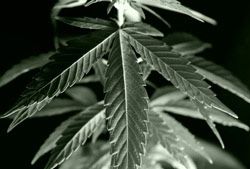'Fake Weed' Crackdown: DEA Calls Chemicals Illegal

Five chemicals used to make fake weed, referred to as K2 and spice, just got an emergency designation by the Drug Enforcement Administration (DEA), making possession and sale of the substances or products containing them illegal in the United States.
The chemicals — called JWH-018, JWH-073, JWH-200, CP-47,497 and cannabicyclohexanol — are considered Schedule 1 under the Controlled Substances Act, a class that also includes heroin and the substances in ecstasy.
The drug is already outlawed in many European countries, at least 18 U.S. states and all branches of the U.S. military, according to the American Psychiatric Association.
"This emergency action was necessary to prevent an imminent threat to public health and safety," according to a DEA statement. The temporary scheduling will remain in place for at least a year while the DEA and U.S. Department of Health and Human Services study whether the chemicals should be permanently controlled.
Last year emergency room reports warned of teens getting high on fake weed that was also causing hallucinations, vomiting, agitation and other dangerous effects. [Designer Drugs Turn Deadly]
"K2 may be a mixture of herbal and spice plant products, but it is sprayed with a potent psychotropic drug and likely contaminated with an unknown toxic substance that is causing many adverse effects," Dr. Anthony Scalzo, a professor of toxicology at St. Louis University, who also directs the Missouri Regional Poison Control Center, told LiveScience last year.
Who concocted K2?
Sign up for the Live Science daily newsletter now
Get the world’s most fascinating discoveries delivered straight to your inbox.
This K2 compound was first created in the mid-1990s in the lab of organic chemist John W. Huffman of Clemson University, who studies cannabinoid receptors. Huffman had published details on a series of compounds, including one now used to make K2 — called JWH-018 for his initials — in a book chapter. But even before that book came out, he recalls learning that people were selling the compound as a plant growth stimulant in China and Korea. So he's not sure how the recipe got out — but it did.
"Apparently somebody picked it up, I think in Europe, on the idea of doping this incense mixture with the compound and smoking it," Huffman told LiveScience last year. "You can get very high on it. It's about 10 times more active than THC," the active ingredient in marijuana.
From a chemist's perspective, that means K2 has an affinity for the cannabinoid brain receptor (CB1) that's about 10 times greater than THC. For the everyday person, it means you can smoke a lot less K2 to get just as high.
Once smoked, the active compound works on the brain in the same way as marijuana's active ingredient THC, or tetrahydrocannabinol. Both compounds bind to the CB1 receptors, which primarily affect the central nervous system. JWH-018 also binds to the peripheral brain (CB2) receptors, which are involved in the immune system, Huffman said.
Not your parents' weed
Last year in the span of about a month, Scalzo saw nearly 30 cases of teenagers experiencing adverse effects after smoking fake weed. While some of the symptoms seemed to match up with smoking too much marijuana, such as hallucinations, others involved agitation along with elevated blood pressure and heart rates that aren't typically seen in marijuana side effects.
Scalza speculated last year that either another compound is responsible for the nasty side effects, or the concentration of JWH-018 is too high.
JWH-018 and other synthetic cannabinoids are a large family of chemically unrelated structures biologically similar to THC. They first showed up in the United States as potential drugs of abuse in November 2008 when U.S. Customs and Border Protection first encountered them, according to the DEA.
"Young people are being harmed when they smoke these dangerous 'fake pot' products and wrongly equate the products' 'legal' retail availability with being 'safe,'" said Michele M. Leonhart, a DEA administrator, in a statement, adding that the new controlled-substances label "will reduce the number of young people being seen in hospital emergency rooms after ingesting these synthetic chemicals to get high."
You can follow LiveScience managing editor Jeanna Bryner on Twitter @jeannabryner. Follow LiveScience for the latest in science news and discoveries on Twitter @livescience and on Facebook.
Jeanna Bryner is managing editor of Scientific American. Previously she was editor in chief of Live Science and, prior to that, an editor at Scholastic's Science World magazine. Bryner has an English degree from Salisbury University, a master's degree in biogeochemistry and environmental sciences from the University of Maryland and a graduate science journalism degree from New York University. She has worked as a biologist in Florida, where she monitored wetlands and did field surveys for endangered species, including the gorgeous Florida Scrub Jay. She also received an ocean sciences journalism fellowship from the Woods Hole Oceanographic Institution. She is a firm believer that science is for everyone and that just about everything can be viewed through the lens of science.
Most Popular

